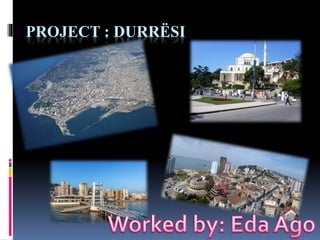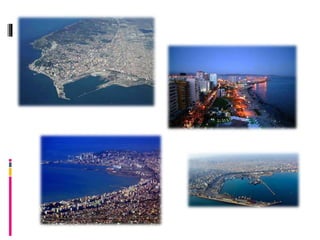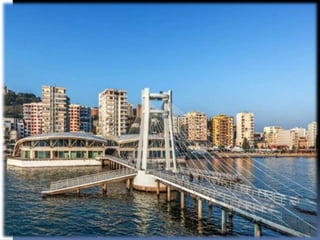Durrës is the second largest city in Albania, located on the Adriatic Sea. Founded by Greek colonists in the 7th century BC as Epidamnos, it later came under Roman and Byzantine rule. During this time, it developed significantly as a military, naval, and economic center. Today, Durrës remains an important port city and is home to several historical and cultural sites, most notably its well-preserved 5th century Byzantine city walls and the largest amphitheater in the Balkans.

![Durrësi
Durrës (Albanian pronunciation: [ˈdu:rəs]; Italian: Durazzo, Italian
pronunciation: [duˈrattso]), historically known as Epidamnos and Dyrrachium, is
the second most populous city of the Republic of Albania. The city is the capital of the
surrounding Durrës County, one of 12 constituent counties of the country. By air, it is 165
kilometres (103 miles) northwest of Sarandë, 31 kilometres (19 miles) west of Tirana, 83
kilometres (52 miles) south of Shkodër and 579 kilometres (360 miles) east of Rome.
Located on the Adriatic Sea, it is the country's most ancient and economic and historic
center.
Founded by Greek colonists from Corinth and Corfu under the name
of Epidamnos (Greek: Επίδαμνος) around the 7th century BC, the city essentially
developed to become significant as it became an integral part of the Roman Empire and
its successor the Byzantine Empire. The Via Egnatia, the continuation of the Via Appia,
started in the city and led across the interior of the Balkan Peninsula to Constantinople in
the east. In the Middle Ages, it was contested
between Bulgarian, Venetianand Ottoman dominions.
Following the Albanian Declaration of Independence, the city served as the capital of
the Principality of Albania for a short period of time. Subsequently, it was annexed by
the Kingdom of Italy and Nazi Germany in the interwar period. Moreover, the city
experienced a strong expansion in its demography and economic activity during
the Communism in Albania.
Durrës is served by the Port of Durrës, one of the largest on the Adriatic Sea, which
connects the city to Italy and other neighbouring countries. Its most considerable
attraction is the Amphitheatre of Durrës that is included on the tentative list of Albania for
designation as a UNESCO World Heritage site. Once having a capacity for 20,000
people, it is the largest amphitheatre in the Balkan Peninsula.](https://image.slidesharecdn.com/projektdurresi-190329181006/85/Projekt-Durresi-2-320.jpg)

![History
Though surviving remains are minimal,[5] as one of the oldest cities in Albania, the city was founded as Epidamnos in the
ancient region of Illyria in 627 BC by ancient Greek[6] colonists from Corinth and Corcyra, modern-dayCorfu.The Romans
replaced the rule ofTeuta with that of Demetrius of Pharos, one of her generals.[7] He lost his kingdom, including Epidamnus,
to the Romans in 219 BC at the Second IllyrianWar. In theThird IllyrianWar Epidamnus was attacked by Gentius but he was
defeated by the Romans[8] at the same year.
For Catullus, the city was Durrachium Hadriae tabernam, "the taberna of theAdriatic", one of the stopping places for a Roman
traveling up the Adriatic, as Catullus had done himself in the sailing season of 56.[9]
After the IllyrianWars with the Roman Republic in 229 BC ended in a decisive defeat for the Illyrians, the city passed to Roman
rule, under which it was developed as a major military and naval base.The Romans renamed it Dyrrachium (Greek: Δυρράχιον
/ Dyrrhachion).They considered the name Epidamnos to be inauspicious because of its wholly coincidental similarities with the
Latin word damnum, meaning "loss" or "harm".The meaning of Dyrrachium ("bad spine" or "difficult ridge" in Greek) is
unclear, but it has been suggested that it refers to the imposing cliffs near the city. Julius Caesar's rival Pompey made a stand
there in 48 BC before fleeing south to Greece. Under Roman rule, Dyrrachium prospered; it became the western end of
the Via Egnatia, the great Roman road that led toThessalonica and on toConstantinople. Another lesser road led south to the
city of Buthrotum, the modern Butrint.The Roman emperor Caesar Augustus made the city a colony for veterans of
his legions following the Battle of Actium, proclaiming it a civitas libera (free town).
In the 4th century, Dyrrachium was made the capital of the Roman province of Epirus nova. It was the birthplace of the
emperor Anastasius I in c. 430. Sometime later that century, Dyrrachium was struck by a powerful earthquake which
destroyed the city's defences.Anastasius I rebuilt and strengthened the city walls, thus creating the strongest fortifications in
the western Balkans.The 12-metre-high (39-foot) walls were so thick that, according to the Byzantine historian Anna
Komnene, four horsemen could ride abreast on them. Significant portions of the ancient city defences still remain, although
they have been much reduced over the centuries.
Like much of the rest of the Balkans, Dyrrachium and the surrounding Dyrraciensis provinciae suffered considerably
from barbarian incursions during the Migrations Period. It was besieged in 481 byTheodoric the Great, king of the Ostrogoths,
and in subsequent centuries had to fend off frequent attacks by the Bulgarians. Unaffected by the fall of theWestern Roman
Empire, the city continued under the Byzantine Empire as an important port and a major link between the Empire and
western Europe.](https://image.slidesharecdn.com/projektdurresi-190329181006/85/Projekt-Durresi-4-320.jpg)
![Culture
One of the city's main sights is the Byzantine city wall, also called Durrës Castle, while the
largest amphitheatre in the Balkans is found close to the city's harbour.This fifth-century
construction is currently under consideration for inscription as a UNESCO World
Heritage site.[32]
The International Film Summerfest of Durrës takes place every summer at the city's
Roman amphitheatre.
The theatrical and musical life of the city is constituted by the Aleksandër MoisiuTheatre,
the Estrada Theater, a puppet theater, and the philharmonic orchestra. The International
Film Summerfest of Durrës, founded in 2008, has since takes place every year in late August
or early September in Durrës Amphitheatre. In 2004 and 2009 Miss Globe International was
held in Durrës.
The city is home to different architectural styles that represent influential periods in its
history.The architecture is influenced by Illyrian, Greek, Roman and Italian architecture. In
the 21st century, part of Durrës has turned into a modernist city, with large blocks of flats,
modern new buildings, new shopping centres and many green spaces.
Museums
Durrës is home to the largest archaeological museum in the country, the Durrës
Archaeological Museum, located near the beach. North of the museum are the sixth-
century Byzantine walls constructed after theVisigothinvasion of 481.The bulk of the
museum consists of artifacts found in the nearby ancient site of Dyrrhachium and includes
an extensive collection from the Illyrian, Ancient Greek, Hellenistic and Roman periods.
Items of major note include Roman funeral steles and stone sarcophagi, an elliptical
colourful mosaic measuring 17 by 10 feet, referred to as The Beauty of Durrës, and a
collection of miniature busts ofVenus, testament to the time when Durrës was a centre of
worship of the goddess. There are several further museums such as the RoyalVilla of
Durrës and the Museum of History (the house of Aleksandër Moisiu).](https://image.slidesharecdn.com/projektdurresi-190329181006/85/Projekt-Durresi-5-320.jpg)
![Roman amphitheatre
The Amphitheatre of Durrës (Albanian: Amfiteatri i Durrësit; Latin: Amphitheatrum
Dyrrhachium) is an amphitheatre in the centre of the city of Durrës, Albania. The
construction began under the emperor Trajan[citation needed] in the 2nd century AD and
destroyed twice by earthquakes in the 6th and 10th centuries.[1] It is the largest
amphitheatre ever built in the Balkan Peninsula with once having a capacity of 20,000
people.[2][3]
The amphitheatre is included on the tentative list of Albania for inscribing it as
a UNESCO World Heritage Site. It was discovered in the late 1966 and has become a
popular tourist attraction in the city as well as in the country.](https://image.slidesharecdn.com/projektdurresi-190329181006/85/Projekt-Durresi-6-320.jpg)
![Great Mosque of Durrës
The Grand Mosque of Durrës (Albanian: Xhamia e Madhe) or New Mosque (Xhamia e Re) is a
historic Albanian Mosque in the port-town of Durrës, Albania.[1]
The old Ottoman mosque before 1931
It was built in 1931 under the Kingdomship of KingAhmet Zogu I on the site of an older mosque
from Ottoman times. By the day of its opening, it was the largest mosque inAlbania.The mosque was closed
in 1967 under the dictatorship of Enver Hoxha and its minaret was torn down. Most other historic mosques of
the Ottoman era were destroyed.[1] From now on, the Main mosque was used as a so-calledYouth Centre. It
was damaged again in 1979 by an earthquake.
With the help of the International Islamic Relief Organization of the MuslimWorld League, the mosque was
reopened again in 1993.
The Mosque is also called Grand Mosque in order to distinguish it from the Little Mosque - the Ottoman-
era Fatih Mosque.](https://image.slidesharecdn.com/projektdurresi-190329181006/85/Projekt-Durresi-7-320.jpg)
![Byzantine city walls
Durrës Castle (Albanian: Kalaja e Durrësit) is the fortified old city of Durrës, Albania. It is enclosed by city
walls built in the late 5th century, and repaired and reinforced in the MiddleAges and early modern
periods.The castle was built by the Byzantine Emperor Anastasius I (r. 491–518), who came from Durrës
(ancient Dyrrhachium). At the time, Anastasius made the city one of the most fortified cities on
the Adriatic.The ancient walls were devastated in an earthquake in 1273, and had to be extensively
repaired.
Durrës in 1573
Currently the medieval walls stand at nearly 15 feet (4.6 meters) in height and the three entrances of
some of the fortification towers are preserved in nearly one-third of the original length of the city walls.
The castle was reinforced with several guard towers by the Republic ofVenice and during the period of
rule in Albania by the Ottoman Empire the wall was reinforced.[1]
On 7 April 1939, Albanian patriots fought the Italian invasion of Albania. In Durrës, a force of only 360
Albanians, mostly gendarmes and townspeople, led by Abaz Kupi, the commander of
the gendarmerie in Durrës, and Mujo Ulqinaku, a marine official, tried to halt the Italian advance. Armed
only with small arms and three machine guns, they succeeded in keeping the Italians at bay for several
hours until a large number of light tanks disembarked from the latter's naval vessels. After that,
resistance diminished and within five hours the Italian forces had captured the entire city.[2]
Today the castle is a popular tourist attraction.](https://image.slidesharecdn.com/projektdurresi-190329181006/85/Projekt-Durresi-8-320.jpg)

